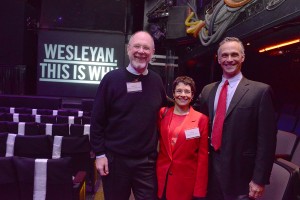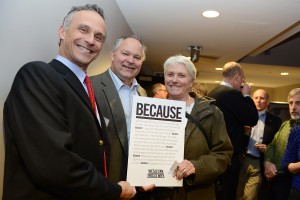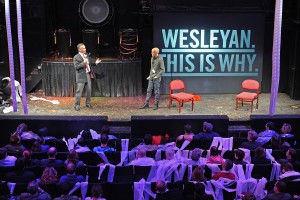Yesterday the Washington Post published my review of Daniel Goleman’s Focus. Ever since my student days at Wesleyan, I’ve had a strong interest in psychology, and watching the increasing vitality of neuroscience on campus (and beyond) in recent years has been fascinating. As a teacher, I often think about the conditions that allow students to really get absorbed in material — be it film, philosophy, literature or history. And I also think about the near constant stream of distractions. I was glad the Post asked me to weigh in on Goleman’s popular consideration of attention.
In the mid-1990s, Daniel Goleman was able to respond to a real cultural need with his bestseller “Emotional Intelligence.” Drawing on the previous decade’s more restrained research on measuring emotional capacity, he boldly argued that tuning into your own and others’ feelings is even more important than the problem-solving skills measured by IQ tests. For Goleman, lots of stuff fell under the rubric of “emotion” — even such things as trustworthiness and teamwork capabilities. Cultivating emotional intelligence sounded a lot like cultivating goodness; it was hard to be against it.
In “Focus,” Goleman looks at the process through which one “tunes in” — whether to emotions, ideas or complex systems. He has a long-standing interest in meditation, and in this book he is able to combine that concern with new research on emotional intelligence, neuropsychology and learning. Whether alone or with others, in certain forms of meditation you learn to monitor your thoughts, to find focus or let it go. Through the practice of meditation, you become more capable of directing your attention — and that can lead to greater happiness and connection to others.
Goleman rightly worries about the hindrances to this capacity to turn oneself to something or someone, and to stay focused. On the other end of the spectrum from the absorptive practice of meditation lies the incessant itch of social media. Technological changes have increased demands on our attention, bombarding us with reminders that there is information that we might look at, queries we might answer. Goleman quotes the economist Herbert Simon on the tidal wave of data coming at us: “a wealth of information creates a poverty of attention.” Simon wrote that in 1977.
“Focus” makes the important point that “the power to disengage our attention from one thing and move it to another is essential for well-being.” Excessive stimulation from our devices, and just from the crowds around us, makes it increasingly difficult to become fully absorbed in anything at all. And full absorption, for Goleman, is fundamental to happiness.
Like many other popular psychology writers, Goleman thinks it’s helpful to refer to parts of the brain to lend credibility to his analyses of our behavior, feelings and thoughts. In discussing a crying baby, for example, he writes about an “agitated amygdala,” as if that had more explanatory heft than just talking about an agitated child. He notes the brain’s “executive” function: “Executive attention holds the key to self management.” But that’s the same as writing that self-management is the key to self-management. His “look, this part of the brain is lighting up” approach to explaining human behavior can at times be just crude. It often adds little or no value.
Goleman keeps returning to brain circuits to make the point that we don’t have a natural ability to stay focused on complex systems and long-term problems. That’s why, he says, folks don’t want to think about the effects of climate change or overpopulation. But why is saying “it’s our brains” a better explanation than saying that people don’t often think about the long term because that makes it harder to think about the short term? Anxiety over punishment, Goleman writes, “actually hampers the child’s prefrontal cortex while he is trying to concentrate and learn,” as if it’s the cortex and not the child that is doing the trying. Why not just say that anxiety hampers the child?
Be that as it may, the book has many interesting points to make about the relationships among focus, empathy, learning and even leadership. Goleman writes about cognitive and emotional empathy, the former as seeing things from another person’s perspective, and the latter as a feeling of compassion and attachment for another. He associates the intellectual aspects of empathy with the highly developed parts of the brain, while the emotional aspects are tied to the deep, primitive brain. Whether this localization of functions helps us understand fellow feeling or not, Goleman’s main point is crucial: “Empathy depends on a muscle of attention.” Exercising this muscle requires self-awareness: “We read other people by tuning in to ourselves.”
So self-awareness helps expand our capacity to be aware of the perspectives, experiences and feelings of others. And this is where Goleman is at his best, describing techniques that expand our comprehension of ourselves and others. Positive reinforcement tends to work better than dire warnings of disaster. For example, there are Web-based apps, such as Handprinter, that emphasize what we can do about climate change, rather than just reminding us how dire the situation is. In schools, there are smart modes of practicing that increase a child’s ability to learn, combining mindfulness and emotional intelligence training with traditional academic subjects. Here the neuroscience does seem to make the presentation more compelling. Goleman explains that games designed to improve attention skills in children enhanced neural scaffolding in measurable ways that benefited emotional and cognitive abilities.
In addition to his work on meditation and emotional intelligence, Goleman has also written for the lucrative business market. Tuning into this opportunity, the penultimate section of this book is titled “the well-focused leader.” Leaders, he tells us, guide the attention of others, and successful leaders “manage” their inner world and their relationships. He offers other bromides, including “we are all leaders in one way or another.” Happily, he says nothing about which parts of a leader’s brain light up when he or she is best inspiring the team.
“Focus” has real moments of insight, strong pages on interesting research and its potential applications. Unfortunately, in trying to be all things to all readers, Goleman’s book fails to consistently sustain and repay our attention.



![photo[6]](https://roth.blogs.wesleyan.edu/files/2013/12/photo6-300x225.jpg)


